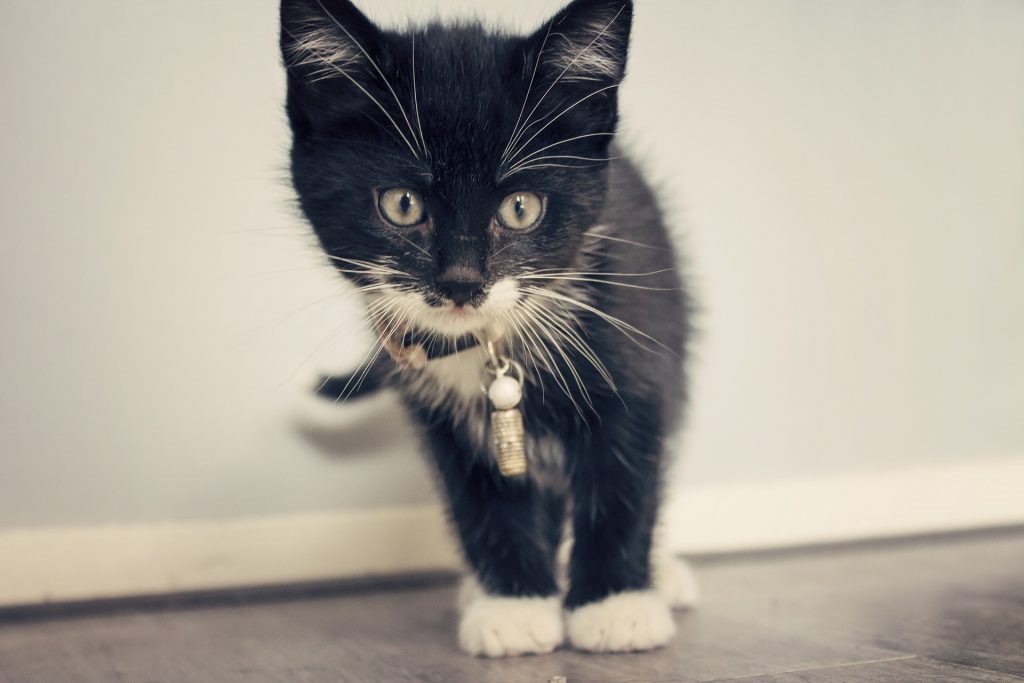Cats, like people, have hair. Which means that cats, like people, can suffer from dandruff. Though it’s doesn’t look appealing, it’s not typically serious.
Dandruff is a collection of dry, dead skin cells that flake from cat’s skin, often related to seborrhea dermatitis. Sometimes those terms are used interchangeably.
Dandruff is not to be confused with dander, however. They are not the same things at all. Dander is when your cat’s dead skin cells shed normally. In fact, it is this dander that is often the trigger for pet allergies in people.
Dandruff, however, occurs when the skin is abnormally dry, and often itchy. Sometimes the skin can be oily and itchy. While dandruff is not a serious problem in and of itself, it is unsightly (at least to humans anyway), and if it is left untreated, your cat could very well scratch himself until his skin until is raw and sore.
This can make your cat vulnerable to potential infection. Also, sometimes dandruff can have a more serious underlying cause, and if that that’s the case and it’s left unchecked, it can endanger the health of your feline friend more than you might initially realize.
What Causes Dandruff in Cats?
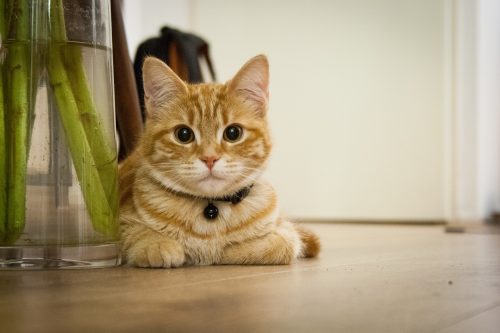
Unfortunately, determining the exact cause of dandruff in a cat can be difficult. It is most often due to an allergic reaction, but that allergic reaction can be triggered by a variety of things.
Those things can range from parasites, such as ticks, feline ringworm, and mites, to allergies to foods or environmental triggers, grooming products, and even sunburn. Anxiety in cats can also be a cause, as well as low humidity.
This is why very dry climates or cold winter months can trigger cases of dandruff in cats. The lack of moisture in the air causes your cat’s skin to become dry and tight, which then turns itchy and flaky.
Parasites
Cat fleas, lice, mites… if your cat has any of these little guys, then he most likely is suffering from dandruff as well. One particular type of mites, called Cheyletiella mites, otherwise known as “walking dandruff,” is a very common cause of unsightly flaking.
These mites are big enough that you can see them with the naked eye, although they are still extremely tiny. Unfortunately, these mites are also quite persistent, and require a different treatment plan than just your typical case of cat dandruff.
Other pesky parasites like the Demodicosis mite can also sometimes be the culprit, although this is rare and is much more prevalent in cats that are ill with compromised immune systems, or cats that are undernourished.
This type of mite can live on the surface layers of the skin or in the hair follicle, and both types of this mite can cause dandruff. Fleas can also be a very common irritant, or more specifically flea saliva. The flea saliva gets injected into your cat’s skin, which causes an allergic reaction that results in excessive scratching and unfortunate flaking.
Sunburn
Like people, cats can also get sunburned, especially on sensitive areas such as their eyelids, nose, ears, and mouth. Cats with thin fur or very light or white-colored fur are also more susceptible to sunburn.
Sunburn essentially fries the top layer of your cat’s skin, and when this happens it becomes dry and flaky. This is why it’s recommended to keep your cat indoors at least during the hottest parts of the day, if not all the time.
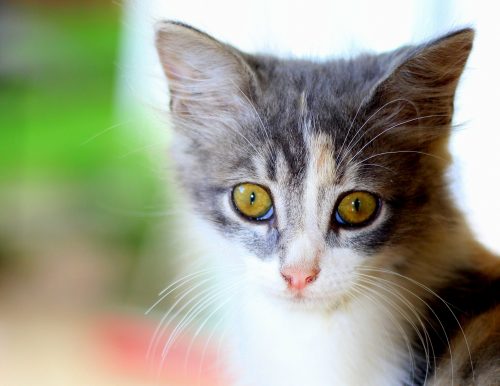
Environmental Changes
Sometimes cats can become stressed or anxious when something in the home has changed. It might be a new renovation, new carpeting, a new family addition, or even just moving furniture around. All of these changes can affect your cat and cause stress and anxiousness.
This stress and anxiousness can trigger dry, itchy skin, and result in flaking and cat dandruff. Sometimes you may need to play detective and take stock of other recent changes that may have occurred, such as with grooming or feeding habits. Even the most minor of changes can trigger a stress response and contribute to dandruff.
Fungal Infections
The most common fungal infections that contribute to cat dandruff are Ringworm and Malassezia. Ringworm is actually a type of yeast infection, but both types of fungal infections can cause crusting, flaking, and itching. Ringworm however, can also result in hair loss in cats.
Seborrhea Dermatitis
This condition is often associated with dandruff, and even confused with dandruff, although the conditions are separate. Despite that, they both go hand in hand. Seborrhea is when your cat’s sebaceous glands produce too much of an oily substance called sebum, which results in itching and flaking. AKA… cat dandruff.
Underlying Diseases
Both hyperthyroidism and feline diabetes are metabolic diseases that can contribute to cat dandruff. However, these diseases are seen more often in cats that are middle-aged or older.
Old Age
Finally, another common culprit to cat dandruff is simply old age. When a cat ages, their skin tends to become dry and even crepe-like. Dry skin, coupled with a reduced flow of blood, makes older cats susceptible to flaking.
Signs & Symptoms of Cat Dandruff
The most common signs of cat dandruff are itchy, dry, and flaky skin. With cats, it will often be seen at the base of the tail, as well as on their face and back. Flakes are seen more readily on cats with dark fur.
Sometimes you will see redness or inflammation, and even thickened, scaly patches. Your cat’s skin may appear greasy, and their coat may be thinner in places and lack the normal luster and sheen it usually has.
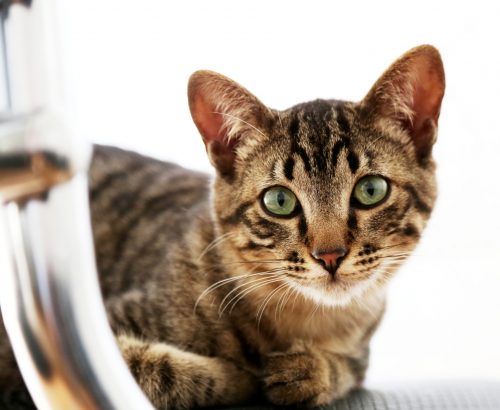
Cats that are obese may often suffer from dandruff too, because their size makes it hard to reach certain areas. Namely the base of the tail and the lower back. This can also be a common problem in cats that suffer from arthritis, as pain and stiffness can keep them from properly grooming those areas.
Another telling sign of cat dandruff is their smell. A cat with dandruff has a distinct odor that you will notice right away. If your cat also has a yeast or bacterial infection, this odor will be even stronger. Make sure to check your cat’s most sensitive areas, like his feet, belly, armpits and thighs, because these places will show redness and inflammation the most.
Treating Dandruff in Cats
Like with dogs, it’s important to make sure you treat any underlying health concerns that may be contributing into your cat’s dandruff.
This means that if your cat suffers from allergies, whether food or environmental related, your vet may recommend changing your cat’s diet, and administering medications such as antihistamines and steroids.
Medicated shampoos can treat conditions such as seborrhea, and Malassezia, and topical and/or oral steroids can be given to your cat in the case of sunburn.
A cat with diabetes may need to change his diet as well, plus receive insulin injections. Meanwhile, cats that suffer from hyperthyroidism may need treatments like radioactive iodine or a special prescription diet with specific iodine levels.
If your cat suffers from mites or fleas, or fungal infections like ringworm, medication will almost certainly be necessary. It is possible your cat may also need regular lime sulfur dips, at least for a time.
Don’t forget that with mites, all bedding will need to be washed with hot water, and any other pets in the home will need to be treated as well to prevent a reinfestation.
Ways to Help Prevent Cat Dandruff
Regular Bathing
Though we know how much cats love a good bath, with some cats it is necessary. Unfortunately, they may need a little help keeping their coat clean and healthy.
You don’t have to bathe them frequently though, maybe every couple of months or so. This will help loosen and release flakes from the skin, and help keep the skin moisturized.
You can use an anti-dandruff shampoo too, as a preventative. If you don’t like to bathe your cat yourself, consider sending them to a groomer. A groomer can bathe them with less fuss, and they can also provide lime sulfur dips if they become necessary.
Reject Obesity
I know many people love the idea of a “fat cat.” However, a fat cat is not a healthy cat. If your cat is so overweight that they can’t groom every part of their coat, their skin can suffer.
Not to mention, cats that are overweight are also more likely to develop arthritis and diabetes, both of which are contributors to cat dandruff and present serious health concerns.
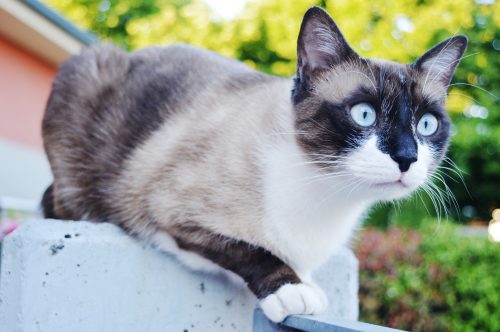
Watch Your Cat’s Diet
The foods they eat and your cat’s water intake can play a big role in the health of your cat and his skin. Your kitty needs to get plenty of water each day, as well as sufficient fatty acids such as omega-3’s.
Try supplementing, as your cat will get more of the vital nutrients that way. If your cat doesn’t seem to be drinking enough on his own, try giving him wet or canned food. You can also try placing multiple water stations throughout the house, as well as using pet water fountains to entice your kitty to drink more often. Cats love moving water.
You might also consider avoiding treats, because cats have a tendency to go for the treats over their food, every time. Since treats do not have the same nutritional value as the food, your cat’s health can suffer as a result.
Keep Your Cat Indoors
This is especially important during the hottest parts of the day, and even more so if your cat is light-colored. The best way to avoid sunburn and the resulting flakiness and dry skin, is to keep your cat protected from the sun.
Consider a Humidifier
Whether you live in a dry climate, or it’s just a dry month, your environment can be the sole cause of your cat’s skin problem. A humidifier can restore the water content into the air, and help keep your kitty’s skin moisturized and healthy.
Regular Brushing
Though your cat may or may not like the attention, brushing your cat regularly can help get rid of dandruff and stimulate the production of oils in your cat’s coat. This is especially helpful if your cat is older, and has a hard time grooming himself properly.
Avoid Sudden Changes
Cats can get stressed and anxious if something in their home changes suddenly. When cats are stressed and anxious they can have physical reactions to that stress, including itchiness and flakiness. Try to keep your cat’s home environment as normal and even-keeled as possible, to protect the health of your pet.
Try Moisturizing
You can get special oils and spray bottles intended for pets, that can help soothe dry skin and provide moisturize. You can also use moisturizing creams, especially those with colloidal oatmeal, and apply them to your cat’s fur. Make sure you rub it in good so that it gets down to the skin, and observe your cat carefully until it’s fully absorbed to make sure he doesn’t lick it.
Ultimately, cat dandruff is more an unappealing annoyance than anything else. However, the underlying cause of the dandruff can hold more serious health concerns, so make sure you take them seriously. With targeted care and treatment, dandruff can be eliminated and kept off of your furry, feline friend for good.

